Sustainability Issues: An Analysis of Changing Global Demographics
VerifiedAdded on 2023/06/11
|10
|2858
|402
Essay
AI Summary
This essay examines the multifaceted impact of changing demographics on global sustainability, addressing environmental, social, economic, and ethical dimensions. It highlights how factors like urbanization, migration, and varying population growth rates in different regions contribute to environmental pressures and social inequalities. The analysis extends to the ethical considerations surrounding family planning, reproductive rights, and the balance between human needs and environmental stewardship. The essay further discusses the opportunities and threats presented by these demographic shifts, including the potential for a skilled workforce and economic growth versus the challenges of an aging population and single-parent families. Ultimately, it underscores the necessity for informed policies and ethical awareness to navigate the complexities of population change and ensure a sustainable future, emphasizing the importance of family planning and education.
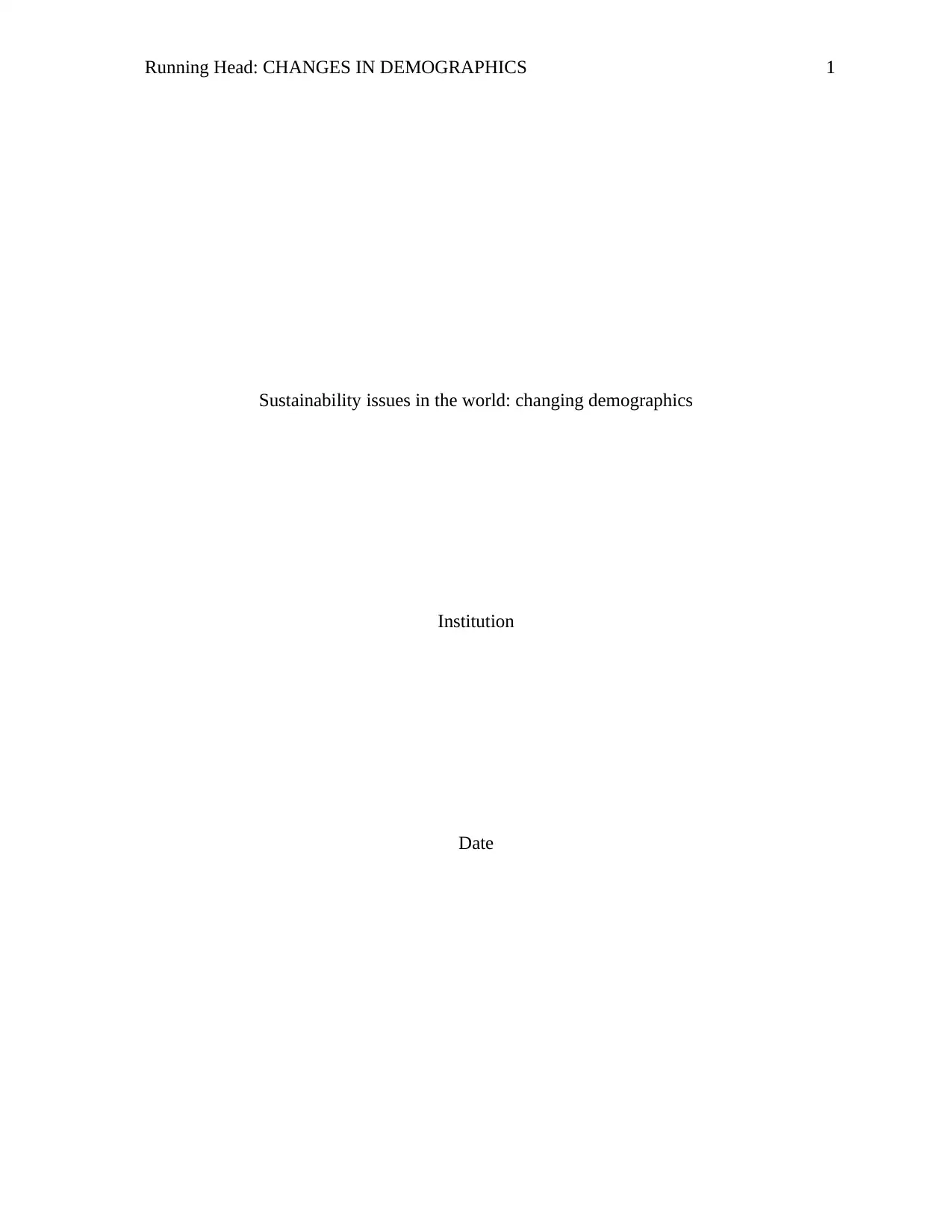
Running Head: CHANGES IN DEMOGRAPHICS 1
Sustainability issues in the world: changing demographics
Institution
Date
Sustainability issues in the world: changing demographics
Institution
Date
Paraphrase This Document
Need a fresh take? Get an instant paraphrase of this document with our AI Paraphraser
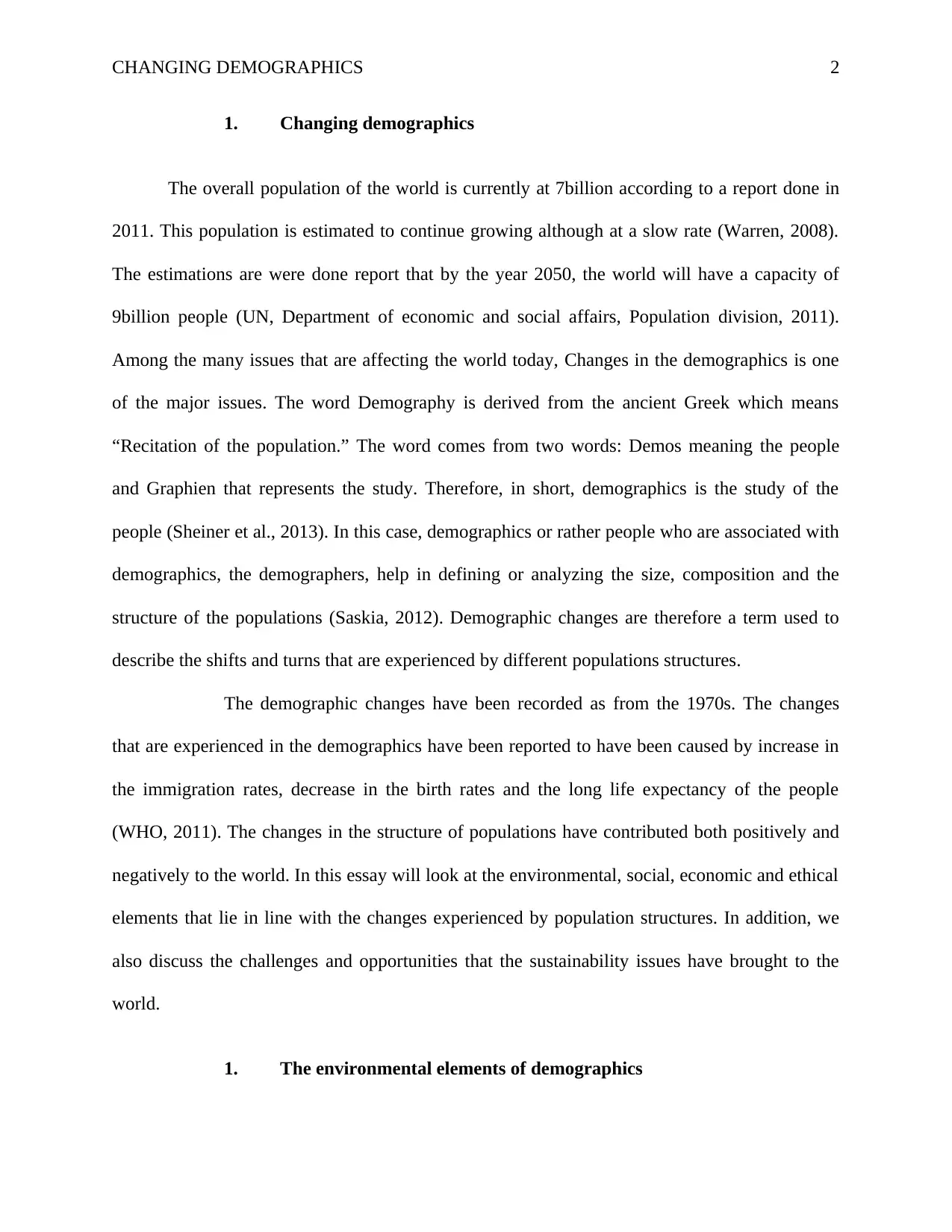
CHANGING DEMOGRAPHICS 2
1. Changing demographics
The overall population of the world is currently at 7billion according to a report done in
2011. This population is estimated to continue growing although at a slow rate (Warren, 2008).
The estimations are were done report that by the year 2050, the world will have a capacity of
9billion people (UN, Department of economic and social affairs, Population division, 2011).
Among the many issues that are affecting the world today, Changes in the demographics is one
of the major issues. The word Demography is derived from the ancient Greek which means
“Recitation of the population.” The word comes from two words: Demos meaning the people
and Graphien that represents the study. Therefore, in short, demographics is the study of the
people (Sheiner et al., 2013). In this case, demographics or rather people who are associated with
demographics, the demographers, help in defining or analyzing the size, composition and the
structure of the populations (Saskia, 2012). Demographic changes are therefore a term used to
describe the shifts and turns that are experienced by different populations structures.
The demographic changes have been recorded as from the 1970s. The changes
that are experienced in the demographics have been reported to have been caused by increase in
the immigration rates, decrease in the birth rates and the long life expectancy of the people
(WHO, 2011). The changes in the structure of populations have contributed both positively and
negatively to the world. In this essay will look at the environmental, social, economic and ethical
elements that lie in line with the changes experienced by population structures. In addition, we
also discuss the challenges and opportunities that the sustainability issues have brought to the
world.
1. The environmental elements of demographics
1. Changing demographics
The overall population of the world is currently at 7billion according to a report done in
2011. This population is estimated to continue growing although at a slow rate (Warren, 2008).
The estimations are were done report that by the year 2050, the world will have a capacity of
9billion people (UN, Department of economic and social affairs, Population division, 2011).
Among the many issues that are affecting the world today, Changes in the demographics is one
of the major issues. The word Demography is derived from the ancient Greek which means
“Recitation of the population.” The word comes from two words: Demos meaning the people
and Graphien that represents the study. Therefore, in short, demographics is the study of the
people (Sheiner et al., 2013). In this case, demographics or rather people who are associated with
demographics, the demographers, help in defining or analyzing the size, composition and the
structure of the populations (Saskia, 2012). Demographic changes are therefore a term used to
describe the shifts and turns that are experienced by different populations structures.
The demographic changes have been recorded as from the 1970s. The changes
that are experienced in the demographics have been reported to have been caused by increase in
the immigration rates, decrease in the birth rates and the long life expectancy of the people
(WHO, 2011). The changes in the structure of populations have contributed both positively and
negatively to the world. In this essay will look at the environmental, social, economic and ethical
elements that lie in line with the changes experienced by population structures. In addition, we
also discuss the challenges and opportunities that the sustainability issues have brought to the
world.
1. The environmental elements of demographics
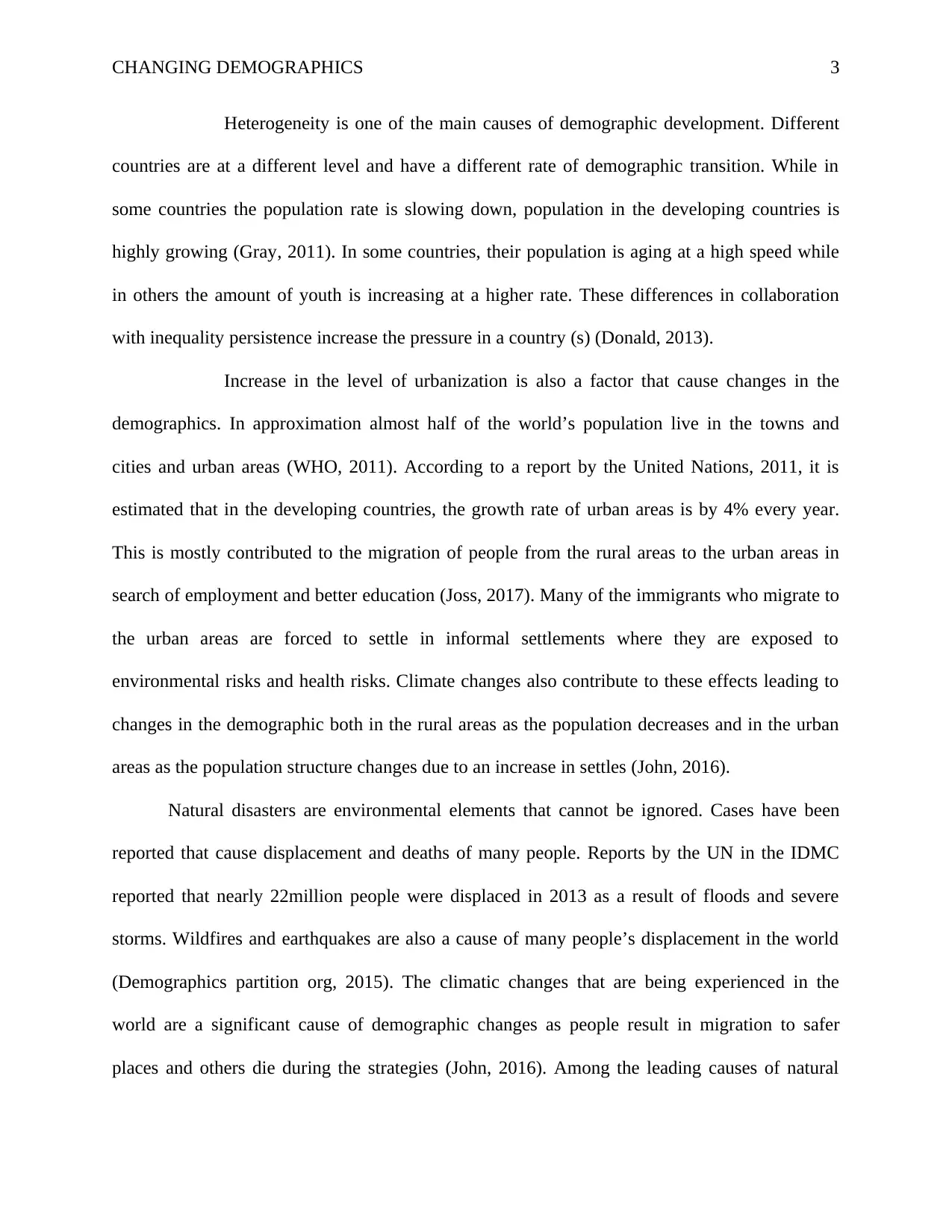
CHANGING DEMOGRAPHICS 3
Heterogeneity is one of the main causes of demographic development. Different
countries are at a different level and have a different rate of demographic transition. While in
some countries the population rate is slowing down, population in the developing countries is
highly growing (Gray, 2011). In some countries, their population is aging at a high speed while
in others the amount of youth is increasing at a higher rate. These differences in collaboration
with inequality persistence increase the pressure in a country (s) (Donald, 2013).
Increase in the level of urbanization is also a factor that cause changes in the
demographics. In approximation almost half of the world’s population live in the towns and
cities and urban areas (WHO, 2011). According to a report by the United Nations, 2011, it is
estimated that in the developing countries, the growth rate of urban areas is by 4% every year.
This is mostly contributed to the migration of people from the rural areas to the urban areas in
search of employment and better education (Joss, 2017). Many of the immigrants who migrate to
the urban areas are forced to settle in informal settlements where they are exposed to
environmental risks and health risks. Climate changes also contribute to these effects leading to
changes in the demographic both in the rural areas as the population decreases and in the urban
areas as the population structure changes due to an increase in settles (John, 2016).
Natural disasters are environmental elements that cannot be ignored. Cases have been
reported that cause displacement and deaths of many people. Reports by the UN in the IDMC
reported that nearly 22million people were displaced in 2013 as a result of floods and severe
storms. Wildfires and earthquakes are also a cause of many people’s displacement in the world
(Demographics partition org, 2015). The climatic changes that are being experienced in the
world are a significant cause of demographic changes as people result in migration to safer
places and others die during the strategies (John, 2016). Among the leading causes of natural
Heterogeneity is one of the main causes of demographic development. Different
countries are at a different level and have a different rate of demographic transition. While in
some countries the population rate is slowing down, population in the developing countries is
highly growing (Gray, 2011). In some countries, their population is aging at a high speed while
in others the amount of youth is increasing at a higher rate. These differences in collaboration
with inequality persistence increase the pressure in a country (s) (Donald, 2013).
Increase in the level of urbanization is also a factor that cause changes in the
demographics. In approximation almost half of the world’s population live in the towns and
cities and urban areas (WHO, 2011). According to a report by the United Nations, 2011, it is
estimated that in the developing countries, the growth rate of urban areas is by 4% every year.
This is mostly contributed to the migration of people from the rural areas to the urban areas in
search of employment and better education (Joss, 2017). Many of the immigrants who migrate to
the urban areas are forced to settle in informal settlements where they are exposed to
environmental risks and health risks. Climate changes also contribute to these effects leading to
changes in the demographic both in the rural areas as the population decreases and in the urban
areas as the population structure changes due to an increase in settles (John, 2016).
Natural disasters are environmental elements that cannot be ignored. Cases have been
reported that cause displacement and deaths of many people. Reports by the UN in the IDMC
reported that nearly 22million people were displaced in 2013 as a result of floods and severe
storms. Wildfires and earthquakes are also a cause of many people’s displacement in the world
(Demographics partition org, 2015). The climatic changes that are being experienced in the
world are a significant cause of demographic changes as people result in migration to safer
places and others die during the strategies (John, 2016). Among the leading causes of natural
⊘ This is a preview!⊘
Do you want full access?
Subscribe today to unlock all pages.

Trusted by 1+ million students worldwide
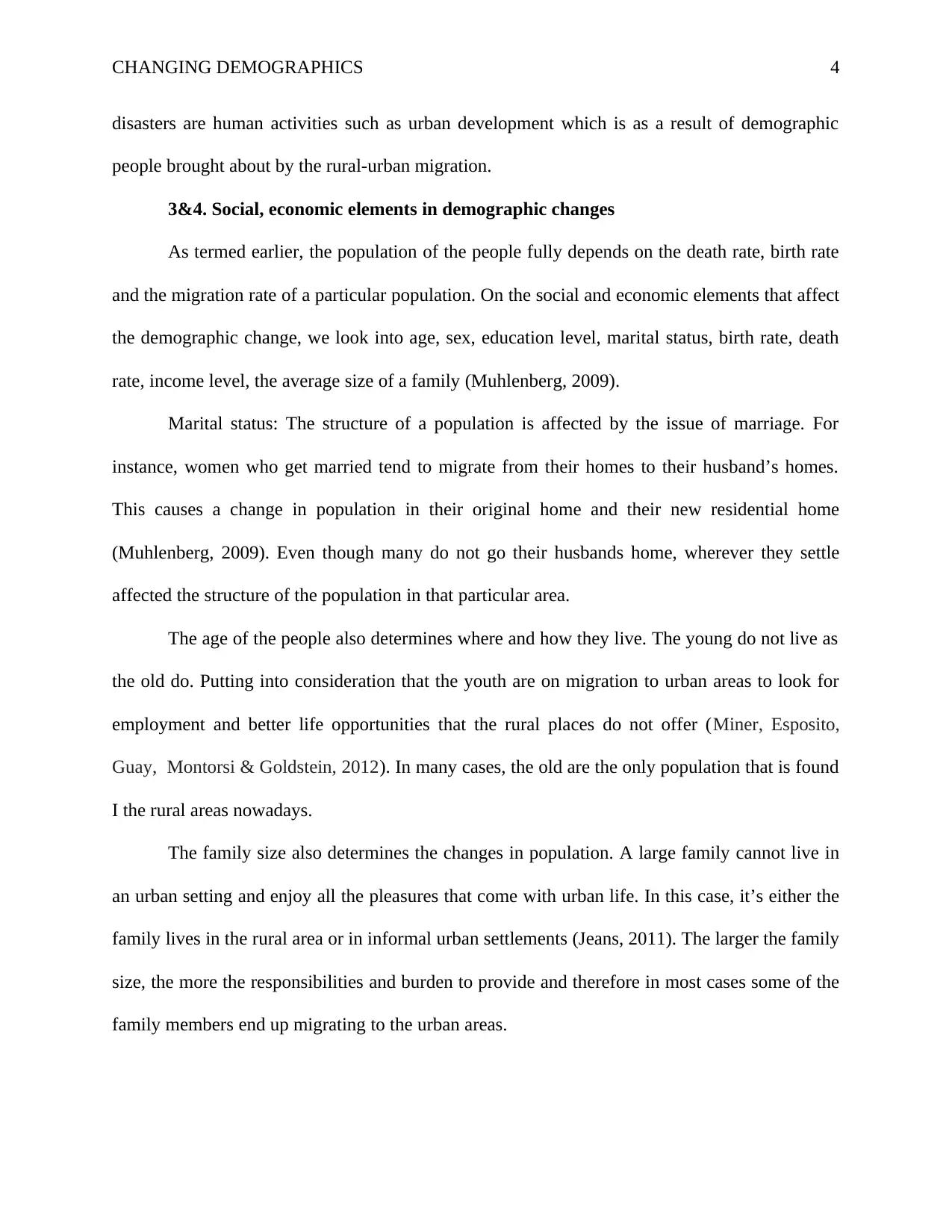
CHANGING DEMOGRAPHICS 4
disasters are human activities such as urban development which is as a result of demographic
people brought about by the rural-urban migration.
3&4. Social, economic elements in demographic changes
As termed earlier, the population of the people fully depends on the death rate, birth rate
and the migration rate of a particular population. On the social and economic elements that affect
the demographic change, we look into age, sex, education level, marital status, birth rate, death
rate, income level, the average size of a family (Muhlenberg, 2009).
Marital status: The structure of a population is affected by the issue of marriage. For
instance, women who get married tend to migrate from their homes to their husband’s homes.
This causes a change in population in their original home and their new residential home
(Muhlenberg, 2009). Even though many do not go their husbands home, wherever they settle
affected the structure of the population in that particular area.
The age of the people also determines where and how they live. The young do not live as
the old do. Putting into consideration that the youth are on migration to urban areas to look for
employment and better life opportunities that the rural places do not offer (Miner, Esposito,
Guay, Montorsi & Goldstein, 2012). In many cases, the old are the only population that is found
I the rural areas nowadays.
The family size also determines the changes in population. A large family cannot live in
an urban setting and enjoy all the pleasures that come with urban life. In this case, it’s either the
family lives in the rural area or in informal urban settlements (Jeans, 2011). The larger the family
size, the more the responsibilities and burden to provide and therefore in most cases some of the
family members end up migrating to the urban areas.
disasters are human activities such as urban development which is as a result of demographic
people brought about by the rural-urban migration.
3&4. Social, economic elements in demographic changes
As termed earlier, the population of the people fully depends on the death rate, birth rate
and the migration rate of a particular population. On the social and economic elements that affect
the demographic change, we look into age, sex, education level, marital status, birth rate, death
rate, income level, the average size of a family (Muhlenberg, 2009).
Marital status: The structure of a population is affected by the issue of marriage. For
instance, women who get married tend to migrate from their homes to their husband’s homes.
This causes a change in population in their original home and their new residential home
(Muhlenberg, 2009). Even though many do not go their husbands home, wherever they settle
affected the structure of the population in that particular area.
The age of the people also determines where and how they live. The young do not live as
the old do. Putting into consideration that the youth are on migration to urban areas to look for
employment and better life opportunities that the rural places do not offer (Miner, Esposito,
Guay, Montorsi & Goldstein, 2012). In many cases, the old are the only population that is found
I the rural areas nowadays.
The family size also determines the changes in population. A large family cannot live in
an urban setting and enjoy all the pleasures that come with urban life. In this case, it’s either the
family lives in the rural area or in informal urban settlements (Jeans, 2011). The larger the family
size, the more the responsibilities and burden to provide and therefore in most cases some of the
family members end up migrating to the urban areas.
Paraphrase This Document
Need a fresh take? Get an instant paraphrase of this document with our AI Paraphraser
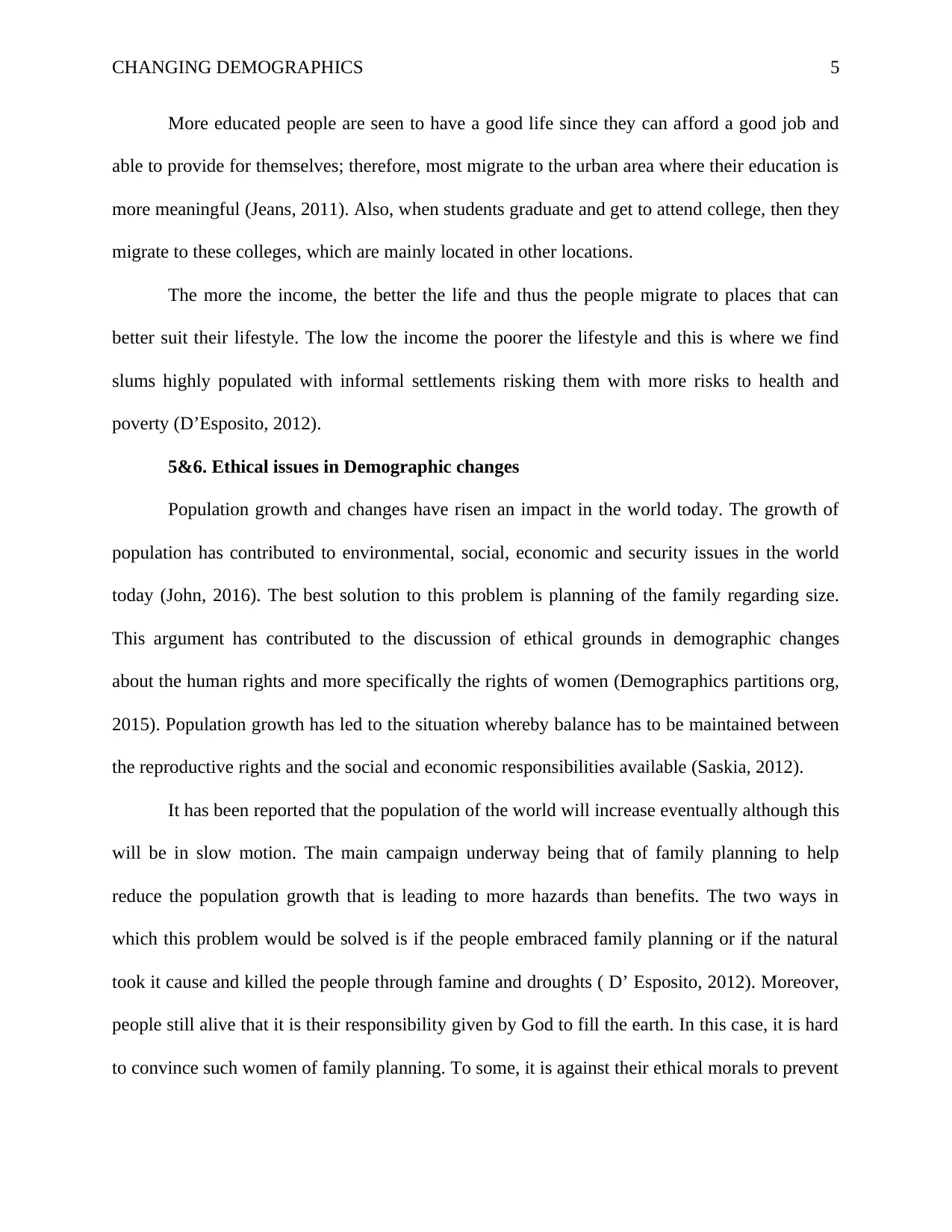
CHANGING DEMOGRAPHICS 5
More educated people are seen to have a good life since they can afford a good job and
able to provide for themselves; therefore, most migrate to the urban area where their education is
more meaningful (Jeans, 2011). Also, when students graduate and get to attend college, then they
migrate to these colleges, which are mainly located in other locations.
The more the income, the better the life and thus the people migrate to places that can
better suit their lifestyle. The low the income the poorer the lifestyle and this is where we find
slums highly populated with informal settlements risking them with more risks to health and
poverty (D’Esposito, 2012).
5&6. Ethical issues in Demographic changes
Population growth and changes have risen an impact in the world today. The growth of
population has contributed to environmental, social, economic and security issues in the world
today (John, 2016). The best solution to this problem is planning of the family regarding size.
This argument has contributed to the discussion of ethical grounds in demographic changes
about the human rights and more specifically the rights of women (Demographics partitions org,
2015). Population growth has led to the situation whereby balance has to be maintained between
the reproductive rights and the social and economic responsibilities available (Saskia, 2012).
It has been reported that the population of the world will increase eventually although this
will be in slow motion. The main campaign underway being that of family planning to help
reduce the population growth that is leading to more hazards than benefits. The two ways in
which this problem would be solved is if the people embraced family planning or if the natural
took it cause and killed the people through famine and droughts ( D’ Esposito, 2012). Moreover,
people still alive that it is their responsibility given by God to fill the earth. In this case, it is hard
to convince such women of family planning. To some, it is against their ethical morals to prevent
More educated people are seen to have a good life since they can afford a good job and
able to provide for themselves; therefore, most migrate to the urban area where their education is
more meaningful (Jeans, 2011). Also, when students graduate and get to attend college, then they
migrate to these colleges, which are mainly located in other locations.
The more the income, the better the life and thus the people migrate to places that can
better suit their lifestyle. The low the income the poorer the lifestyle and this is where we find
slums highly populated with informal settlements risking them with more risks to health and
poverty (D’Esposito, 2012).
5&6. Ethical issues in Demographic changes
Population growth and changes have risen an impact in the world today. The growth of
population has contributed to environmental, social, economic and security issues in the world
today (John, 2016). The best solution to this problem is planning of the family regarding size.
This argument has contributed to the discussion of ethical grounds in demographic changes
about the human rights and more specifically the rights of women (Demographics partitions org,
2015). Population growth has led to the situation whereby balance has to be maintained between
the reproductive rights and the social and economic responsibilities available (Saskia, 2012).
It has been reported that the population of the world will increase eventually although this
will be in slow motion. The main campaign underway being that of family planning to help
reduce the population growth that is leading to more hazards than benefits. The two ways in
which this problem would be solved is if the people embraced family planning or if the natural
took it cause and killed the people through famine and droughts ( D’ Esposito, 2012). Moreover,
people still alive that it is their responsibility given by God to fill the earth. In this case, it is hard
to convince such women of family planning. To some, it is against their ethical morals to prevent
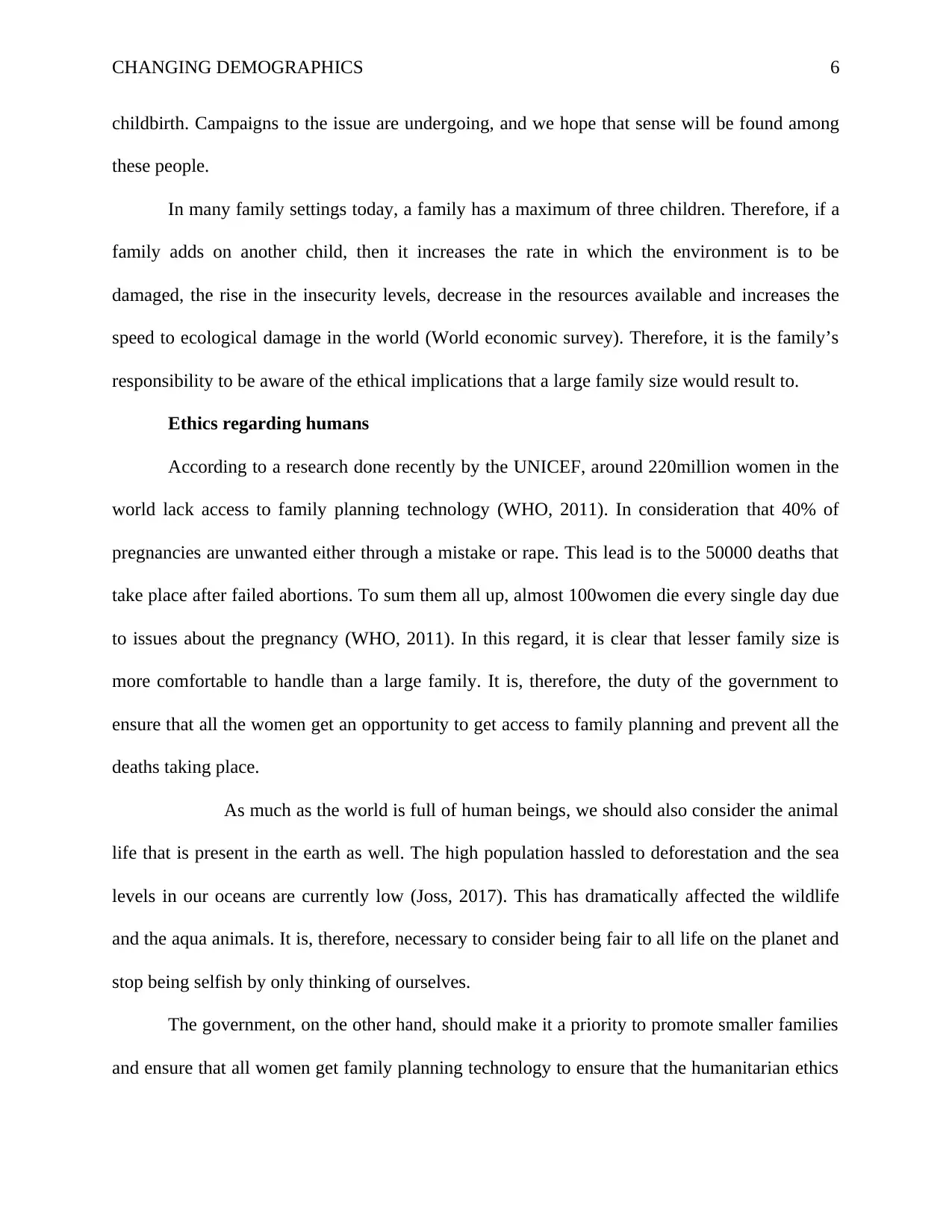
CHANGING DEMOGRAPHICS 6
childbirth. Campaigns to the issue are undergoing, and we hope that sense will be found among
these people.
In many family settings today, a family has a maximum of three children. Therefore, if a
family adds on another child, then it increases the rate in which the environment is to be
damaged, the rise in the insecurity levels, decrease in the resources available and increases the
speed to ecological damage in the world (World economic survey). Therefore, it is the family’s
responsibility to be aware of the ethical implications that a large family size would result to.
Ethics regarding humans
According to a research done recently by the UNICEF, around 220million women in the
world lack access to family planning technology (WHO, 2011). In consideration that 40% of
pregnancies are unwanted either through a mistake or rape. This lead is to the 50000 deaths that
take place after failed abortions. To sum them all up, almost 100women die every single day due
to issues about the pregnancy (WHO, 2011). In this regard, it is clear that lesser family size is
more comfortable to handle than a large family. It is, therefore, the duty of the government to
ensure that all the women get an opportunity to get access to family planning and prevent all the
deaths taking place.
As much as the world is full of human beings, we should also consider the animal
life that is present in the earth as well. The high population hassled to deforestation and the sea
levels in our oceans are currently low (Joss, 2017). This has dramatically affected the wildlife
and the aqua animals. It is, therefore, necessary to consider being fair to all life on the planet and
stop being selfish by only thinking of ourselves.
The government, on the other hand, should make it a priority to promote smaller families
and ensure that all women get family planning technology to ensure that the humanitarian ethics
childbirth. Campaigns to the issue are undergoing, and we hope that sense will be found among
these people.
In many family settings today, a family has a maximum of three children. Therefore, if a
family adds on another child, then it increases the rate in which the environment is to be
damaged, the rise in the insecurity levels, decrease in the resources available and increases the
speed to ecological damage in the world (World economic survey). Therefore, it is the family’s
responsibility to be aware of the ethical implications that a large family size would result to.
Ethics regarding humans
According to a research done recently by the UNICEF, around 220million women in the
world lack access to family planning technology (WHO, 2011). In consideration that 40% of
pregnancies are unwanted either through a mistake or rape. This lead is to the 50000 deaths that
take place after failed abortions. To sum them all up, almost 100women die every single day due
to issues about the pregnancy (WHO, 2011). In this regard, it is clear that lesser family size is
more comfortable to handle than a large family. It is, therefore, the duty of the government to
ensure that all the women get an opportunity to get access to family planning and prevent all the
deaths taking place.
As much as the world is full of human beings, we should also consider the animal
life that is present in the earth as well. The high population hassled to deforestation and the sea
levels in our oceans are currently low (Joss, 2017). This has dramatically affected the wildlife
and the aqua animals. It is, therefore, necessary to consider being fair to all life on the planet and
stop being selfish by only thinking of ourselves.
The government, on the other hand, should make it a priority to promote smaller families
and ensure that all women get family planning technology to ensure that the humanitarian ethics
⊘ This is a preview!⊘
Do you want full access?
Subscribe today to unlock all pages.

Trusted by 1+ million students worldwide
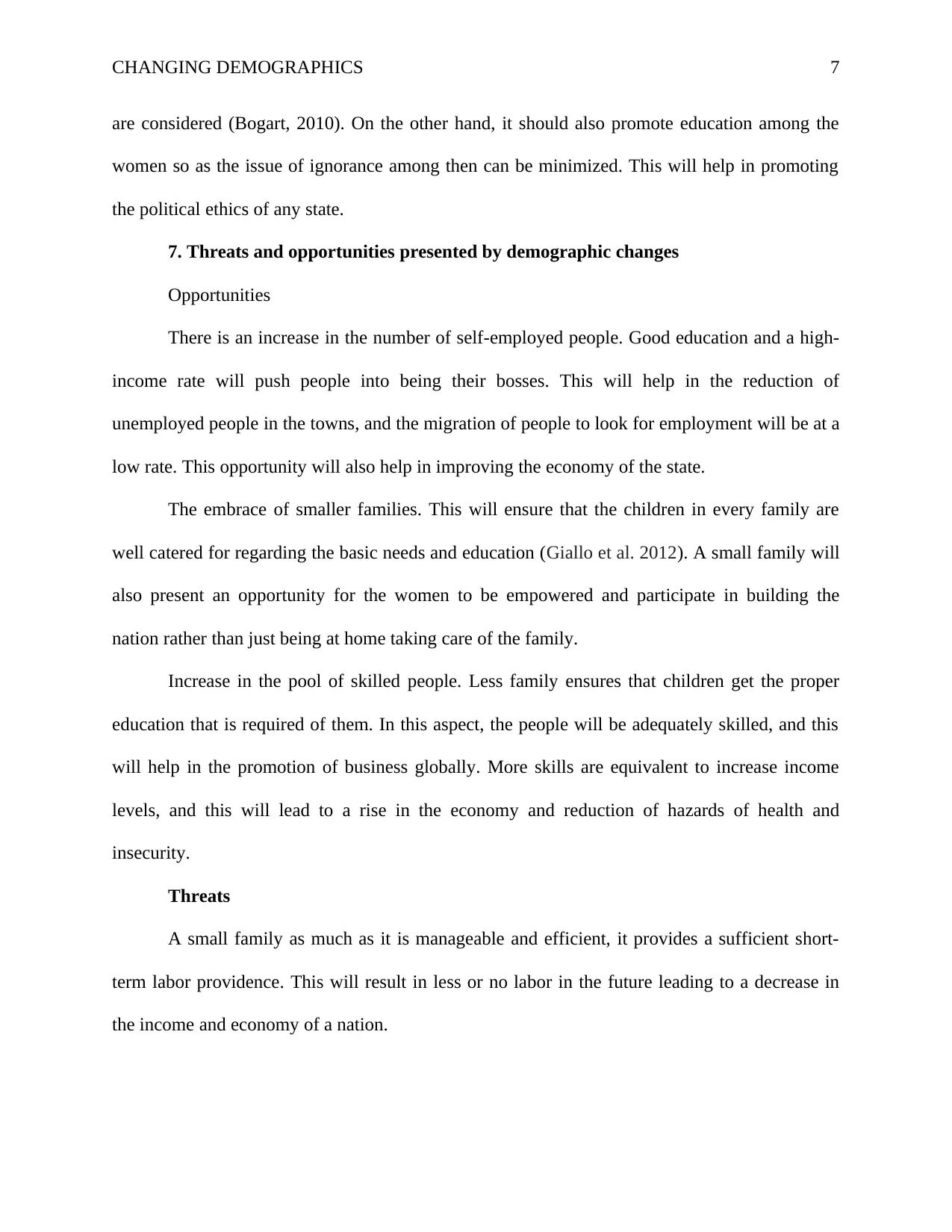
CHANGING DEMOGRAPHICS 7
are considered (Bogart, 2010). On the other hand, it should also promote education among the
women so as the issue of ignorance among then can be minimized. This will help in promoting
the political ethics of any state.
7. Threats and opportunities presented by demographic changes
Opportunities
There is an increase in the number of self-employed people. Good education and a high-
income rate will push people into being their bosses. This will help in the reduction of
unemployed people in the towns, and the migration of people to look for employment will be at a
low rate. This opportunity will also help in improving the economy of the state.
The embrace of smaller families. This will ensure that the children in every family are
well catered for regarding the basic needs and education (Giallo et al. 2012). A small family will
also present an opportunity for the women to be empowered and participate in building the
nation rather than just being at home taking care of the family.
Increase in the pool of skilled people. Less family ensures that children get the proper
education that is required of them. In this aspect, the people will be adequately skilled, and this
will help in the promotion of business globally. More skills are equivalent to increase income
levels, and this will lead to a rise in the economy and reduction of hazards of health and
insecurity.
Threats
A small family as much as it is manageable and efficient, it provides a sufficient short-
term labor providence. This will result in less or no labor in the future leading to a decrease in
the income and economy of a nation.
are considered (Bogart, 2010). On the other hand, it should also promote education among the
women so as the issue of ignorance among then can be minimized. This will help in promoting
the political ethics of any state.
7. Threats and opportunities presented by demographic changes
Opportunities
There is an increase in the number of self-employed people. Good education and a high-
income rate will push people into being their bosses. This will help in the reduction of
unemployed people in the towns, and the migration of people to look for employment will be at a
low rate. This opportunity will also help in improving the economy of the state.
The embrace of smaller families. This will ensure that the children in every family are
well catered for regarding the basic needs and education (Giallo et al. 2012). A small family will
also present an opportunity for the women to be empowered and participate in building the
nation rather than just being at home taking care of the family.
Increase in the pool of skilled people. Less family ensures that children get the proper
education that is required of them. In this aspect, the people will be adequately skilled, and this
will help in the promotion of business globally. More skills are equivalent to increase income
levels, and this will lead to a rise in the economy and reduction of hazards of health and
insecurity.
Threats
A small family as much as it is manageable and efficient, it provides a sufficient short-
term labor providence. This will result in less or no labor in the future leading to a decrease in
the income and economy of a nation.
Paraphrase This Document
Need a fresh take? Get an instant paraphrase of this document with our AI Paraphraser
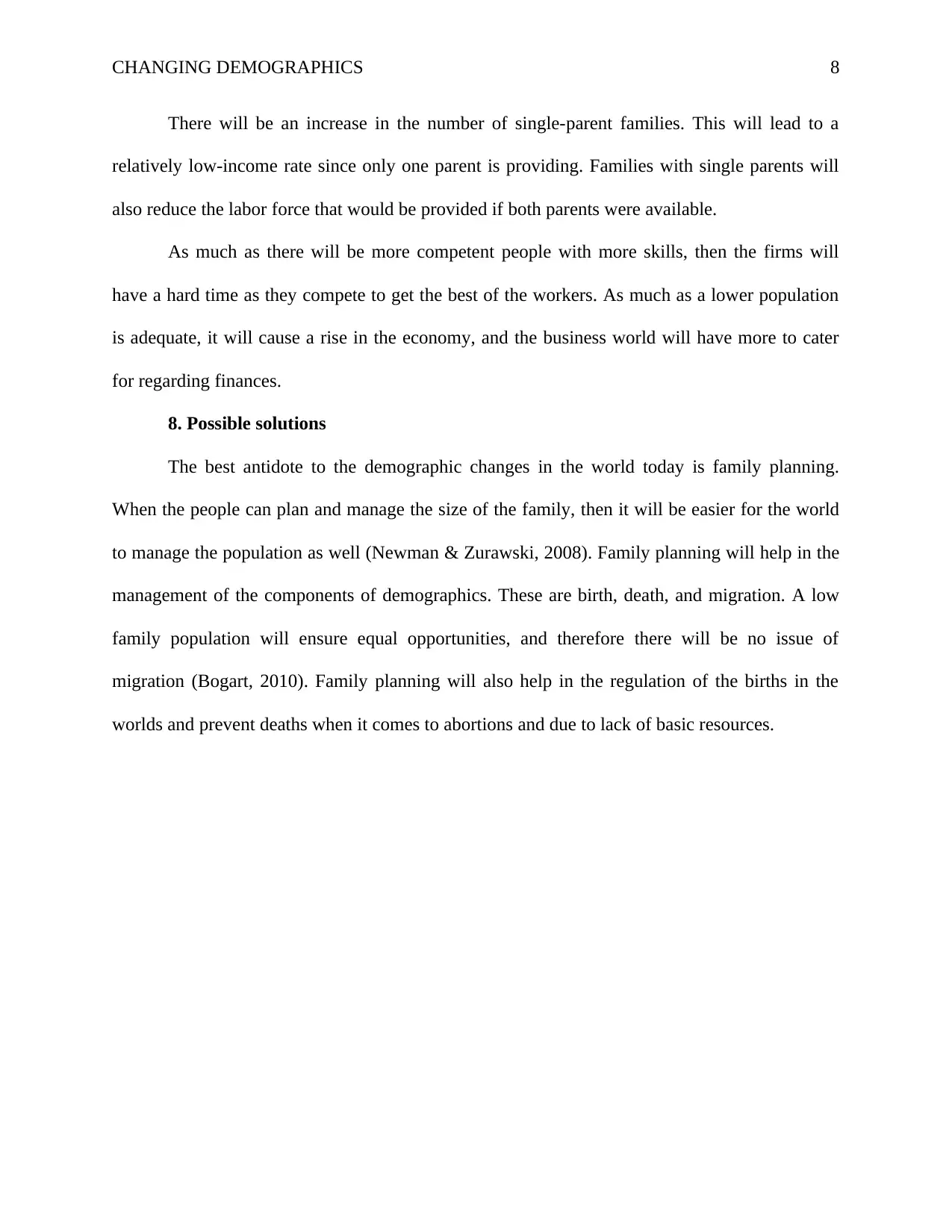
CHANGING DEMOGRAPHICS 8
There will be an increase in the number of single-parent families. This will lead to a
relatively low-income rate since only one parent is providing. Families with single parents will
also reduce the labor force that would be provided if both parents were available.
As much as there will be more competent people with more skills, then the firms will
have a hard time as they compete to get the best of the workers. As much as a lower population
is adequate, it will cause a rise in the economy, and the business world will have more to cater
for regarding finances.
8. Possible solutions
The best antidote to the demographic changes in the world today is family planning.
When the people can plan and manage the size of the family, then it will be easier for the world
to manage the population as well (Newman & Zurawski, 2008). Family planning will help in the
management of the components of demographics. These are birth, death, and migration. A low
family population will ensure equal opportunities, and therefore there will be no issue of
migration (Bogart, 2010). Family planning will also help in the regulation of the births in the
worlds and prevent deaths when it comes to abortions and due to lack of basic resources.
There will be an increase in the number of single-parent families. This will lead to a
relatively low-income rate since only one parent is providing. Families with single parents will
also reduce the labor force that would be provided if both parents were available.
As much as there will be more competent people with more skills, then the firms will
have a hard time as they compete to get the best of the workers. As much as a lower population
is adequate, it will cause a rise in the economy, and the business world will have more to cater
for regarding finances.
8. Possible solutions
The best antidote to the demographic changes in the world today is family planning.
When the people can plan and manage the size of the family, then it will be easier for the world
to manage the population as well (Newman & Zurawski, 2008). Family planning will help in the
management of the components of demographics. These are birth, death, and migration. A low
family population will ensure equal opportunities, and therefore there will be no issue of
migration (Bogart, 2010). Family planning will also help in the regulation of the births in the
worlds and prevent deaths when it comes to abortions and due to lack of basic resources.
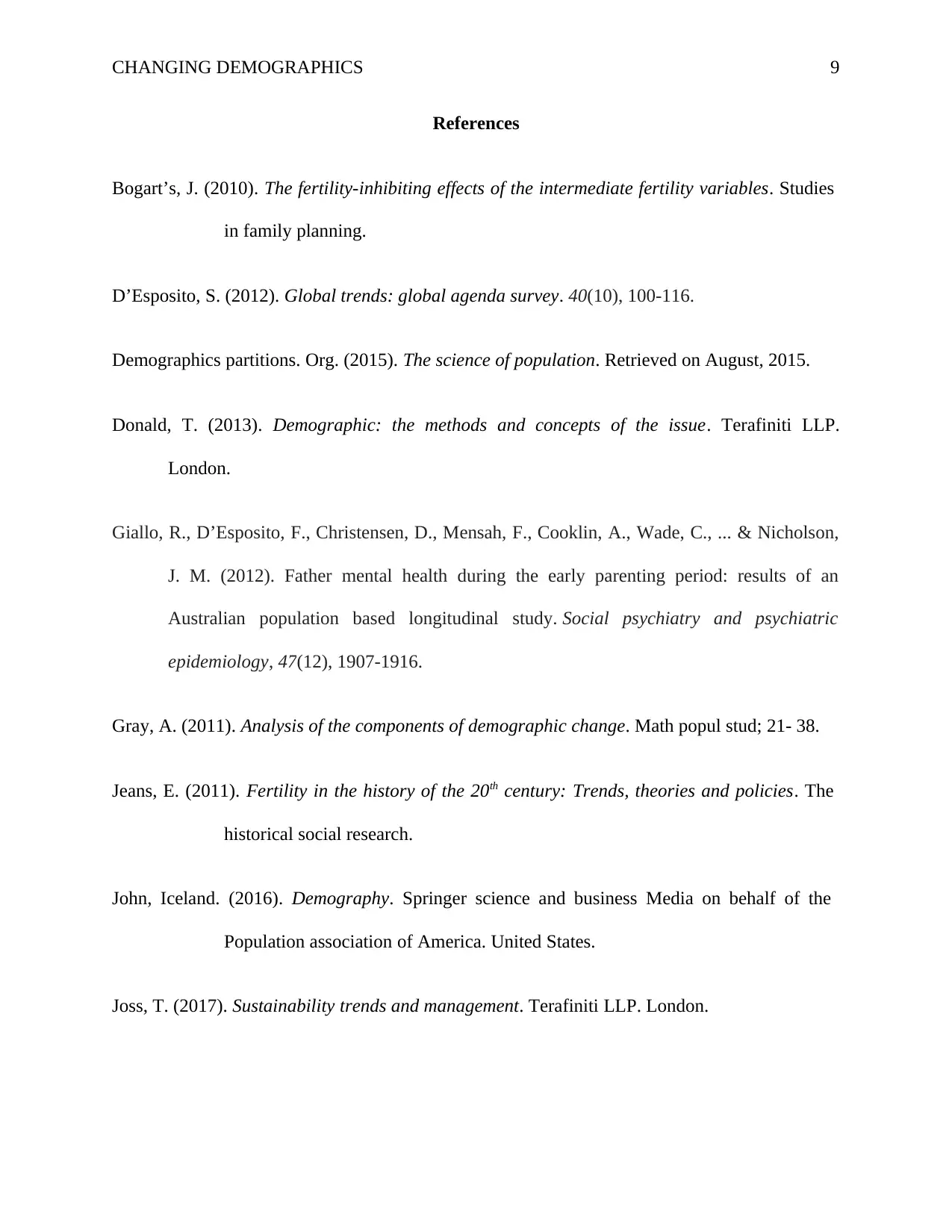
CHANGING DEMOGRAPHICS 9
References
Bogart’s, J. (2010). The fertility-inhibiting effects of the intermediate fertility variables. Studies
in family planning.
D’Esposito, S. (2012). Global trends: global agenda survey. 40(10), 100-116.
Demographics partitions. Org. (2015). The science of population. Retrieved on August, 2015.
Donald, T. (2013). Demographic: the methods and concepts of the issue. Terafiniti LLP.
London.
Giallo, R., D’Esposito, F., Christensen, D., Mensah, F., Cooklin, A., Wade, C., ... & Nicholson,
J. M. (2012). Father mental health during the early parenting period: results of an
Australian population based longitudinal study. Social psychiatry and psychiatric
epidemiology, 47(12), 1907-1916.
Gray, A. (2011). Analysis of the components of demographic change. Math popul stud; 21- 38.
Jeans, E. (2011). Fertility in the history of the 20th century: Trends, theories and policies. The
historical social research.
John, Iceland. (2016). Demography. Springer science and business Media on behalf of the
Population association of America. United States.
Joss, T. (2017). Sustainability trends and management. Terafiniti LLP. London.
References
Bogart’s, J. (2010). The fertility-inhibiting effects of the intermediate fertility variables. Studies
in family planning.
D’Esposito, S. (2012). Global trends: global agenda survey. 40(10), 100-116.
Demographics partitions. Org. (2015). The science of population. Retrieved on August, 2015.
Donald, T. (2013). Demographic: the methods and concepts of the issue. Terafiniti LLP.
London.
Giallo, R., D’Esposito, F., Christensen, D., Mensah, F., Cooklin, A., Wade, C., ... & Nicholson,
J. M. (2012). Father mental health during the early parenting period: results of an
Australian population based longitudinal study. Social psychiatry and psychiatric
epidemiology, 47(12), 1907-1916.
Gray, A. (2011). Analysis of the components of demographic change. Math popul stud; 21- 38.
Jeans, E. (2011). Fertility in the history of the 20th century: Trends, theories and policies. The
historical social research.
John, Iceland. (2016). Demography. Springer science and business Media on behalf of the
Population association of America. United States.
Joss, T. (2017). Sustainability trends and management. Terafiniti LLP. London.
⊘ This is a preview!⊘
Do you want full access?
Subscribe today to unlock all pages.

Trusted by 1+ million students worldwide
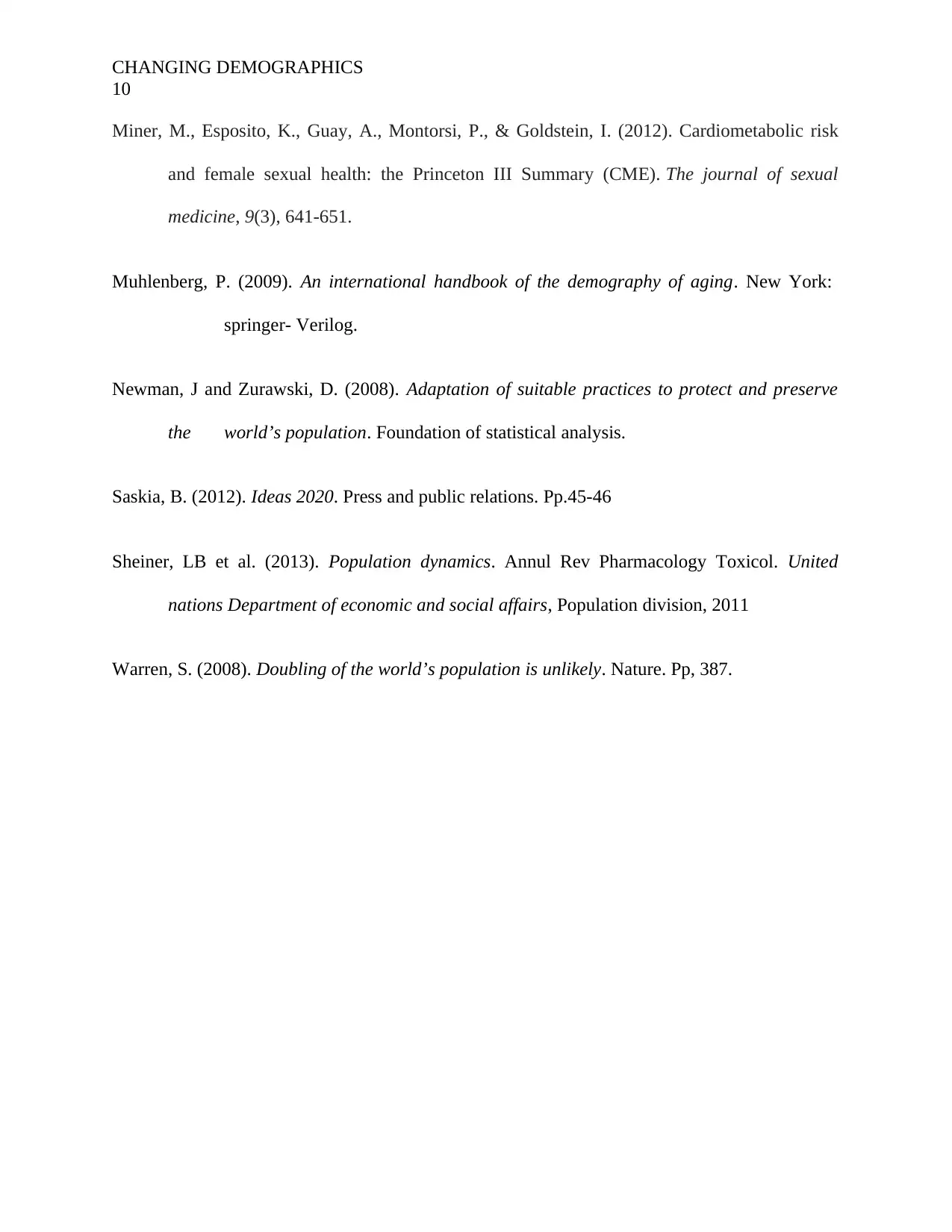
CHANGING DEMOGRAPHICS
10
Miner, M., Esposito, K., Guay, A., Montorsi, P., & Goldstein, I. (2012). Cardiometabolic risk
and female sexual health: the Princeton III Summary (CME). The journal of sexual
medicine, 9(3), 641-651.
Muhlenberg, P. (2009). An international handbook of the demography of aging. New York:
springer- Verilog.
Newman, J and Zurawski, D. (2008). Adaptation of suitable practices to protect and preserve
the world’s population. Foundation of statistical analysis.
Saskia, B. (2012). Ideas 2020. Press and public relations. Pp.45-46
Sheiner, LB et al. (2013). Population dynamics. Annul Rev Pharmacology Toxicol. United
nations Department of economic and social affairs, Population division, 2011
Warren, S. (2008). Doubling of the world’s population is unlikely. Nature. Pp, 387.
10
Miner, M., Esposito, K., Guay, A., Montorsi, P., & Goldstein, I. (2012). Cardiometabolic risk
and female sexual health: the Princeton III Summary (CME). The journal of sexual
medicine, 9(3), 641-651.
Muhlenberg, P. (2009). An international handbook of the demography of aging. New York:
springer- Verilog.
Newman, J and Zurawski, D. (2008). Adaptation of suitable practices to protect and preserve
the world’s population. Foundation of statistical analysis.
Saskia, B. (2012). Ideas 2020. Press and public relations. Pp.45-46
Sheiner, LB et al. (2013). Population dynamics. Annul Rev Pharmacology Toxicol. United
nations Department of economic and social affairs, Population division, 2011
Warren, S. (2008). Doubling of the world’s population is unlikely. Nature. Pp, 387.
1 out of 10
Related Documents
Your All-in-One AI-Powered Toolkit for Academic Success.
+13062052269
info@desklib.com
Available 24*7 on WhatsApp / Email
![[object Object]](/_next/static/media/star-bottom.7253800d.svg)
Unlock your academic potential
Copyright © 2020–2025 A2Z Services. All Rights Reserved. Developed and managed by ZUCOL.





